Design and Description of the CMS Magnetic System Model
Abstract
:1. Introduction
2. Materials and Methods
2.1. The CMS Detector Description
2.2. Formulation of the Magnetostatic Problem for Modelling the Magnetic Flux of the CMS Superconducting Solenoid
3. Results
3.1. Description of the CMS Superconducting Solenoid Model
3.2. Description of the CMS Magnet Yoke Model
3.3. Magnetization Curves of Steel in the CMS Magnet Model
4. Discussion
5. Conclusions
Funding
Institutional Review Board Statement
Informed Consent Statement
Data Availability Statement
Acknowledgments
Conflicts of Interest
References
- Aad, G.; Abajyan, T.; Abbott, B.; Abdallah, J.; Khalek, S.A.; Abdelalim, A.; Abdinov, O.; Aben, R.; Abi, B.; Abolins, M.; et al. Observation of a new particle in the search for the Standard Model Higgs boson with the ATLAS detector at the LHC. Phys. Lett. B 2012, 716, 1–29. [Google Scholar] [CrossRef]
- Chatrchyan, S.; Khachatryan, V.; Sirunyan, A.; Tumasyan, A.; Adam, W.; Aguilo, E.; Bergauer, T.; Dragicevic, M.; Erö, J.; Fabjan, C.; et al. Observation of a new boson at a mass of 125 GeV with the CMS experiment at the LHC. Phys. Lett. B 2012, 716, 30–61. [Google Scholar] [CrossRef]
- Chatrchyan, S.; The CMS Collaboration; Khachatryan, V.; Sirunyan, A.M.; Tumasyan, A.; Adam, W.; Bergauer, T.; Dragicevic, M.; Erö, J.; Fabjan, C.; et al. Observation of a new boson with mass near 125 GeV in pp collisions at √s = 7 and 8 TeV. J. High Energy Phys. 2013, 2013, 81. [Google Scholar] [CrossRef] [Green Version]
- Dittmaier, S.; Mariotti, C.; Passarino, G.; Tanaka, R. (Eds.) Handbook of LHC Higgs Cross Sections: 1. Inclusive Observables; Report CERN-2011-002 of the LHC Higgs Cross Section Working Group; CERN: Geneva, Switzerland, 2011; ISBN 978-92-9083-358-1. Available online: http://cds.cern.ch/record/1318996 (accessed on 9 June 2021).
- Englert, F.; Brout, R. Broken symmetry and the masses of gauge vector mesons. Phys. Rev. Lett. 1964, 13, 321–323. [Google Scholar] [CrossRef] [Green Version]
- Higgs, P. Broken symmetries, massless particles and gauge fields. Phys. Lett. 1964, 12, 132–133. [Google Scholar] [CrossRef]
- Higgs, P.W. Broken Symmetries and the Masses of Gauge Bosons. Phys. Rev. Lett. 1964, 13, 508–509. [Google Scholar] [CrossRef] [Green Version]
- Evans, L.; Bryant, P. LHC Machine. J. Instrum. 2008, 3, S08001. [Google Scholar] [CrossRef] [Green Version]
- Lorentz, H.A. La théorie électromagnétique de Maxwell et son application aux corps mouvants. Arch. Néerl. 1892, 25, 451. [Google Scholar]
- ATLAS Collaboration. The ATLAS Experiment at the CERN Large Hadron Collider. J. Instrum. 2008, 3, S08003. [Google Scholar] [CrossRef] [Green Version]
- CMS Collaboration. The CMS Experiment at the CERN LHC. J. Instrum. 2008, 3, S08004. [Google Scholar] [CrossRef] [Green Version]
- Vishnyakov, I.A.; Vorob’ev, A.P.; Kechkin, V.F.; Klyukhin, V.I.; Kozlovsky, E.A.; Malyaev, V.K.; Selivanov, G.I. Superconducting solenoid for a collider detector. Zhurnal Tekhnicheskoi Fiziki 1992, 62, 146–156. (In Russian) [Google Scholar]
- Vishnyakov, I.A.; Vorob’ev, A.P.; Kechkin, V.F.; Klyukhin, V.I.; Kozlovsky, E.A.; Malyaev, V.K.; Selivanov, G.I. Superconducting solenoid for a colliding beams device. Sov. Phys. Tech. Phys. 1992, 37, 195–201. [Google Scholar]
- The DØ Collaboration. E823 (DØ Upgrade): Magnetic Tracking; D0 Note 1933; FNAL: Batavia, IL, USA, 1993. Available online: https://inspirehep.net/literature/1234049 (accessed on 9 June 2021).
- The DØ Collaboration. DØ Upgrade. FERMILAB-PROPOSAL-0823; FNAL: Batavia, IL, USA, 1993. Available online: https://inspirehep.net/literature/362587 (accessed on 9 June 2021).
- The DØ Collaboration. The DØ Upgrade. FERMILAB-Conf-95/177-E; FNAL: Batavia, IL, USA, 1995. Available online: https://inspirehep.net/literature/397654 (accessed on 9 June 2021).
- Wayne, M.R. The DØ upgrade. Nucl. Instrum. Methods Phys. Res. Sect. A Accel. Spectrometer Detect. Assoc. Equip. 1998, 408, 103–109. [Google Scholar] [CrossRef]
- CMS. The Magnet Project; Technical Design Report, CERN/LHCC 97-10, CMS TDR 1; CERN: Geneva, Switzerland, 1997; ISBN 92-9083-101-4. Available online: http://cds.cern.ch/record/331056 (accessed on 9 June 2021).
- ATLAS. Magnet System; Technical Design Report, CERN/LHCC 97-18, ATLAS TDR 6; CERN: Geneva, Switzerland, 1997; ISBN 92-9083-104-9. Available online: http://cds.cern.ch/record/338080 (accessed on 9 June 2021).
- Galić, H.; Wohl, C.; Armstrong, B.; Dodder, D.; Klyukhin, V.; Ryabov, Y.; Illarionova, N.; Lehar, F.; Oyanagi, Y.; Olin, A.; et al. Current Experiments in Elementary Particle Physics. Technical Report LBL-91-Rev.-6-92; 1992; p. 131. Available online: https://www.osti.gov/biblio/10181103 (accessed on 9 June 2021).
- Galic, H.; Lehar, F.; Klyukhin, V.; Ryabov, Y.; Bilak, S.; Illarionova, N.; Khachaturov, B.; Strokovsky, E.; Hoffman, C.; Kettle, P.-R.; et al. Current Experiments in Particle Physics. Technical Report LBL-91-Rev.-9-96; 1996; p. 46. Available online: https://www.osti.gov/biblio/469140 (accessed on 9 June 2021).
- The LHC Study Group. Design Study of the Large Hadron Collider (LHC). A Multiparticle Collider in the LEP Tunnel; CERN-91-03, CERN-AC-DI-FA-90-06-REV; CERN: Geneva, Switzerland, 1991. [Google Scholar] [CrossRef]
- CMS. The Compact Muon Solenoid. Letter of Intent by the CMS Collaboration for a General Purpose Detector at the LHC; CERN/LHCC/92-3; LHCC/I 1; CERN: Geneva, Switzerland, 1992; Available online: https://cds.cern.ch/record/290808 (accessed on 9 June 2021).
- ATLAS. Letter of Intent for a General-Purpose PP Experiment at the Large Hadron Collider at CERN; CERN/LHCC/92-4, LHCC/I 2; CERN: Geneva, Switzerland, 1992; Available online: http://cds.cern.ch/record/291061 (accessed on 9 June 2021).
- Erdogan, A.; Zmushko, V.V.; Klyukhin, V.I.; Froidevaux, D. Study of the H → WW → lνjj and H → ZZ → lljj decays for mH = 1 TeV/c2 at the LHC energies. Yadernaya Fizika 1994, 59, 290–301. (In Russian) [Google Scholar]
- Erdogan, A.; Froidevaux, D.; Klyukhin, V.; Zmushko, V. On the Experimental study of the H → WW → lνjj and H → ZZ → lljj Decays for mH = 1 TeV/c2 at LHC energies. Phys. Atom. Nucl. 1994, 57, 274–284. [Google Scholar]
- Zmushko, S.; Erdogan, A.; Froidevaux, D.; Klioukhine, S. Study of H → WW → Lνjj and H → ZZ → Lljj Decays for mH = 1 TeV; ATLAS Internal note PHYS-No-008; CERN: Geneva, Switzerland, 1992; Available online: https://cds.cern.ch/record/682128 (accessed on 9 June 2021).
- ATLAS. Technical Proposal for a General-Purpose PP Experiment at the Large Hadron Collider at CERN; CERN/LHCC/94-43, LHCC/P2; CERN: Geneva, Switzerland, 1994; pp. 233–235. ISBN 92-9083-067-0. Available online: http://cds.cern.ch/record/290968 (accessed on 9 June 2021).
- Klyukhin, V.I.; Poppleton, A.; Schmitz, J. Magnetic Field Integrals for the ATLAS Tracking Volume; IHEP: Protvino, Russia, 1993. [Google Scholar]
- Klyukhin, V.I.; Poppleton, A.; Schmitz, J. Field Integrals for the ATLAS Tracking Volume; ATLAS Internal note INDET-NO-023; CERN: Geneva, Switzerland, 1993; Available online: http://cds.cern.ch/record/685858 (accessed on 9 June 2021).
- ALICE. Technical Proposal for a Large Ion Collider Experiment at the LHC; CERN/LHCC 95-71, LHCC/P3; CERN: Geneva, Switzerland, 1995; pp. 99–101. ISBN 92-9083-088-077-8. Available online: http://cds.cern.ch/record/293391 (accessed on 9 June 2021).
- ALICE. The Forward Muon Spectrometer; Addendum to the ALICE Technical Proposal. CERN/LHCC 96-32, LHCC/P3-Addendum 1; CERN: Geneva, Switzerland, 1996; pp. 9–10. ISBN 92-9083-088-3. Available online: http://cds.cern.ch/record/314011 (accessed on 9 June 2021).
- Herve, A. Constructing a 4-Tesla Large Thin Solenoid at the Limit of What Can Be Safely Operated. Mod. Phys. Lett. A 2010, 25, 1647–1666. [Google Scholar] [CrossRef]
- Kircher, F.; Bredy, P.; Calvo, A.; Cure, B.; Campi, D.; Desirelli, A.; Fabbricatore, P.; Farinon, S.; Herve, A.; Horvath, I.; et al. Final design of the CMS solenoid cold mass. IEEE Trans. Appl. Supercond. 2000, 10, 407–410. [Google Scholar] [CrossRef]
- Herve, A.; Blau, B.; Bredy, P.; Campi, D.; Cannarsa, P.; Cure, B.; Dupont, T.; Fabbricatore, P.; Farinon, S.; Feyzi, F.; et al. Status of the Construction of the CMS Magnet. IEEE Trans. Appl. Supercond. 2004, 14, 542–547. [Google Scholar] [CrossRef]
- Campi, D.; Cure, B.; Gaddi, A.; Gerwig, H.; Herve, A.; Klyukhin, V.; Maire, G.; Perinic, G.; Bredy, P.; Fazilleau, P.; et al. Commissioning of the CMS Magnet. IEEE Trans. Appl. Supercond. 2007, 17, 1185–1190. [Google Scholar] [CrossRef]
- CMS Collaboration. Commissioning and performance of the CMS pixel tracker with cosmic ray muons. J. Instrum. 2010, 5, T03007. [Google Scholar] [CrossRef]
- CMS Collaboration. Commissioning and performance of the CMS silicon strip tracker with cosmic ray muons. J. Instrum. 2010, 5, T03008. [Google Scholar] [CrossRef]
- CMS Collaboration. Performance and operation of the CMS electromagnetic calorimeter. J. Instrum. 2010, 5, T03010. [Google Scholar] [CrossRef]
- CMS Collaboration. Performance of the CMS hadron calorimeter with cosmic ray muons and LHC beam data. J. Instrum. 2010, 5, T03012. [Google Scholar] [CrossRef]
- CMS Collaboration. Performance of the CMS drift tube chambers with cosmic rays. J. Instrum. 2010, 5, T03015. [Google Scholar] [CrossRef]
- CMS Collaboration. Performance of the CMS cathode strip chambers with cosmic rays. J. Instrum. 2010, 5, T03018. [Google Scholar] [CrossRef]
- CMS Collaboration. Performance study of the CMS barrel resistive plate chambers with cosmic rays. J. Instrum. 2010, 5, T03017. [Google Scholar] [CrossRef]
- CMS Collaboration. Performance of CMS muon reconstruction in cosmic-ray events. J. Instrum. 2010, 5, T03022. [Google Scholar] [CrossRef]
- Abdullin, S.; The CMS-HCAL Collaboration; Abramov, V.; Acharya, B.; Adams, M.; Akchurin, N.; Akgun, U.; Anderson, E.; Antchev, G.; Arcidy, M.; et al. Design, performance, and calibration of CMS forward calorimeter wedges. Eur. Phys. J. C 2007, 53, 139–166. [Google Scholar] [CrossRef] [Green Version]
- CMS Collaboration. Precise mapping of the magnetic field in the CMS barrel yoke using cosmic rays. J. Instrum. 2010, 5, T03021. [Google Scholar] [CrossRef] [Green Version]
- Klioukhine, V.; Campi, D.; Cure, B.; Desirelli, A.; Farinon, S.; Gerwig, H.; Grillet, J.; Herve, A.; Kircher, F.; Levesy, B.; et al. 3D magnetic analysis of the CMS magnet. IEEE Trans. Appl. Supercond. 2000, 10, 428–431. [Google Scholar] [CrossRef] [Green Version]
- Klyukhin, V.I.; Ball, A.; Campi, D.; Cure, B.; Dattola, D.; Gaddi, A.; Gerwig, H.; Hervé, A.; Loveless, R.; Reithler, H.; et al. Measuring the Magnetic Field Inside the CMS Steel Yoke Elements. In Proceedings of the 2008 IEEE Nuclear Science Symposium Conference Record, Dresden, Germany, 19–25 October 2008; pp. 2270–2273. [Google Scholar]
- Klyukhin, V.I.; Amapane, N.; Andreev, V.; Ball, A.; Cure, B.; Herve, A.; Gaddi, A.; Gerwig, H.; Karimaki, V.; Loveless, R.; et al. The CMS Magnetic Field Map Performance. IEEE Trans. Appl. Supercond. 2010, 20, 152–155. [Google Scholar] [CrossRef] [Green Version]
- Klyukhin, V.I.; Amapane, N.; Ball, A.; Cure, B.; Gaddi, A.; Gerwig, H.; Mulders, M.; Herve, A.; Loveless, R. Measuring the Magnetic Flux Density in the CMS Steel Yoke. J. Supercond. Nov. Magn. 2012, 26, 1307–1311. [Google Scholar] [CrossRef] [Green Version]
- Klyukhin, V.I.; Amapane, N.; Ball, A.; Cure, B.; Gaddi, A.; Gerwig, H.; Mulders, M.; Calvelli, V.; Herve, A.; Loveless, R. Validation of the CMS Magnetic Field Map. J. Supercond. Nov. Magn. 2014, 28, 701–704. [Google Scholar] [CrossRef] [Green Version]
- Klyukhin, V.I.; Amapane, N.; Ball, A.; Curé, B.; Gaddi, A.; Gerwig, H.; Mulders, M.; Hervé, A.; Loveless, R. Flux Loop Measurements of the Magnetic Flux Density in the CMS Magnet Yoke. J. Supercond. Nov. Magn. 2016, 30, 2977–2980. [Google Scholar] [CrossRef] [Green Version]
- Klyukhin, V.I.; Cure, B.; Amapane, N.; Ball, A.; Gaddi, A.; Gerwig, H.; Herve, A.; Loveless, R.; Mulders, M. Using the Standard Linear Ramps of the CMS Superconducting Magnet for Measuring the Magnetic Flux Density in the Steel Flux-Return Yoke. IEEE Trans. Magn. 2018, 55, 8300504. [Google Scholar] [CrossRef]
- TOSCA/OPERA-3d 18R2 Reference Manual; Cobham CTS Ltd.: Kidlington, UK, 2018; pp. 1–916.
- Simkin, J.; Trowbridge, C. Three-dimensional nonlinear electromagnetic field computations, using scalar potentials. In IEE Proceedings B Electric Power Applications; Institution of Engineering and Technology (IET): London, UK, 1980; Volume 127, pp. 368–374. [Google Scholar] [CrossRef] [Green Version]
- Landau, L.D.; Lifshitz, E.M. Electrodynamics of Continuous Media, 2nd ed.; Nauka: Moscow, Russia, 1982; pp. 154–163. (In Russian) [Google Scholar]
- Simkin, J.; Trowbridge, C.W. On the use of the total scalar potential on the numerical solution of fields problems in electromagnetics. Int. J. Numer. Methods Eng. 1979, 14, 423–440. [Google Scholar] [CrossRef]
- Tamm, I.E. Fundamentals of the Theory of Electricity, 9th ed.; Nauka: Moscow, Russia, 1976; pp. 285–288. (In Russian) [Google Scholar]
- Zienkiewicz, O.; Lyness, J.; Owen, D. Three-dimensional magnetic field determination using a scalar potential—A finite element solution. IEEE Trans. Magn. 1977, 13, 1649–1656. [Google Scholar] [CrossRef]
- Herve, A. The CMS detector magnet. IEEE Trans. Appl. Supercond. 2000, 10, 389–394. [Google Scholar] [CrossRef] [Green Version]
- Horvath, I.; Dardel, B.; Marti, H.-P.; Neuenschwander, J.; Smith, R.; Fabbricatore, P.; Musenich, R.; Calvo, A.; Campi, D.; Cure, B.; et al. The CMS conductor. IEEE Trans. Appl. Supercond. 2000, 10, 395–398. [Google Scholar] [CrossRef]
- Klioukhine, V. Calculation of Magnetic Forces on the CMS Coil with TOSCA; DSM/DAPNIA/STCM Technical Report 5C 2100T–M 1000 020 97. 1997. Available online: http://klyukhi.web.cern.ch/klyukhi/notes/V_Klioukhine_Saclay_020_1997.pdf (accessed on 9 June 2021).
- Klioukhine, V. Magnetic Forces in the CMS Magnetic System Calculated with TOSCA; DSM/DAPNIA/STCM Technical Report 5C 2100T–M 1000 023 97. 1997. Available online: http://klyukhi.web.cern.ch/klyukhi/notes/V_Klioukhine_Saclay_023_1997.pdf (accessed on 9 June 2021).
- Klioukhine, V.I. The TOSCA-GEANT Interface Tools; CMS Conference Report CMS CR 1998/016; CERN: Geneva, Switzerland, 1998; Available online: https://cds.cern.ch/record/687563 (accessed on 9 June 2021).
- Klyukhin, V.I. Interface Program for POISSON and GEANT Packages. In Proceedings of the International Conference on Computing in High Energy Physics ’92, Annecy, France, 21–25 September 1992; CERN Report, 92-07. Verkerk, C., Wójcik, W., Eds.; CERN: Geneva, Switzerland, 1992; pp. 844–846, ISBN 92-9083-049-2. Available online: http://cds.cern.ch/record/401030 (accessed on 9 June 2021).
- Amapane, N.; Andreev, V.; Drollinger, V.; Karimaki, V.; Klyukhin, V.; Todorov, T. Volume-Based Representation of the Magnetic Field; CMS Conference Report CMS CR 2005/011; CERN: Geneva, Switzerland, 2005; Available online: https://cds.cern.ch/record/883293 (accessed on 9 June 2021).
- Klyukhin, V.; Ball, A.; Bergsma, F.; Campi, D.; Cure, B.; Gaddi, A.; Gerwig, H.; Herve, A.; Korienek, J.; Linde, F.; et al. Measurement of the CMS Magnetic Field. IEEE Trans. Appl. Supercond. 2008, 18, 395–398. [Google Scholar] [CrossRef] [Green Version]


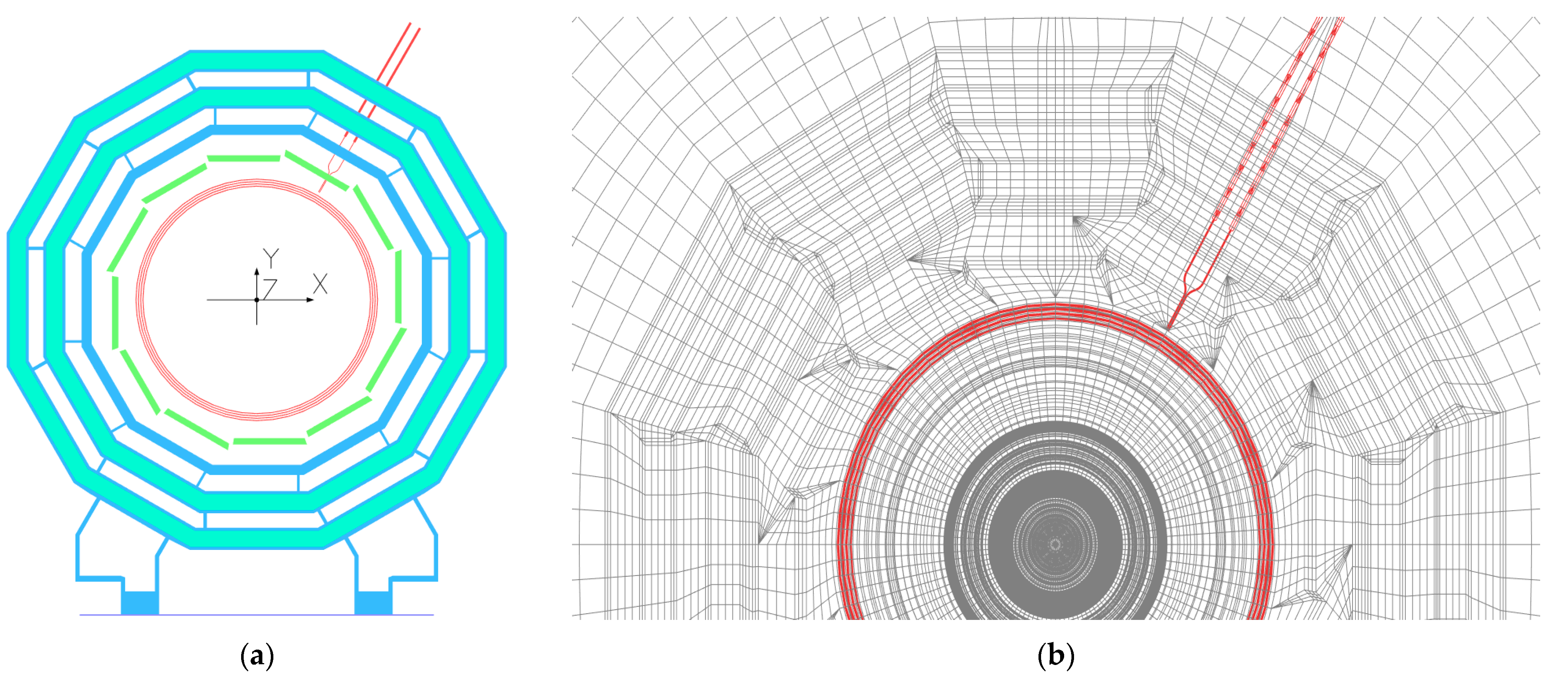

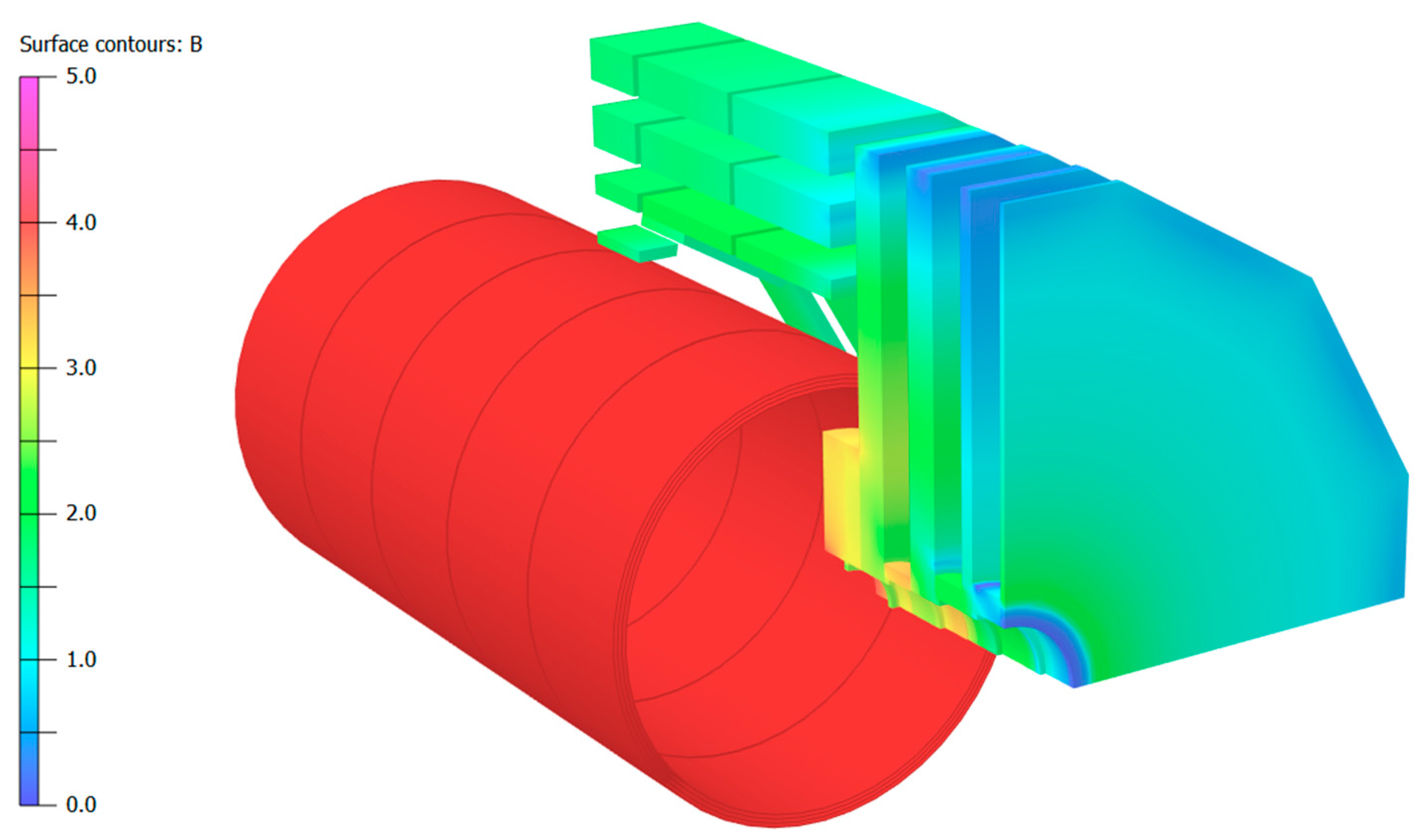
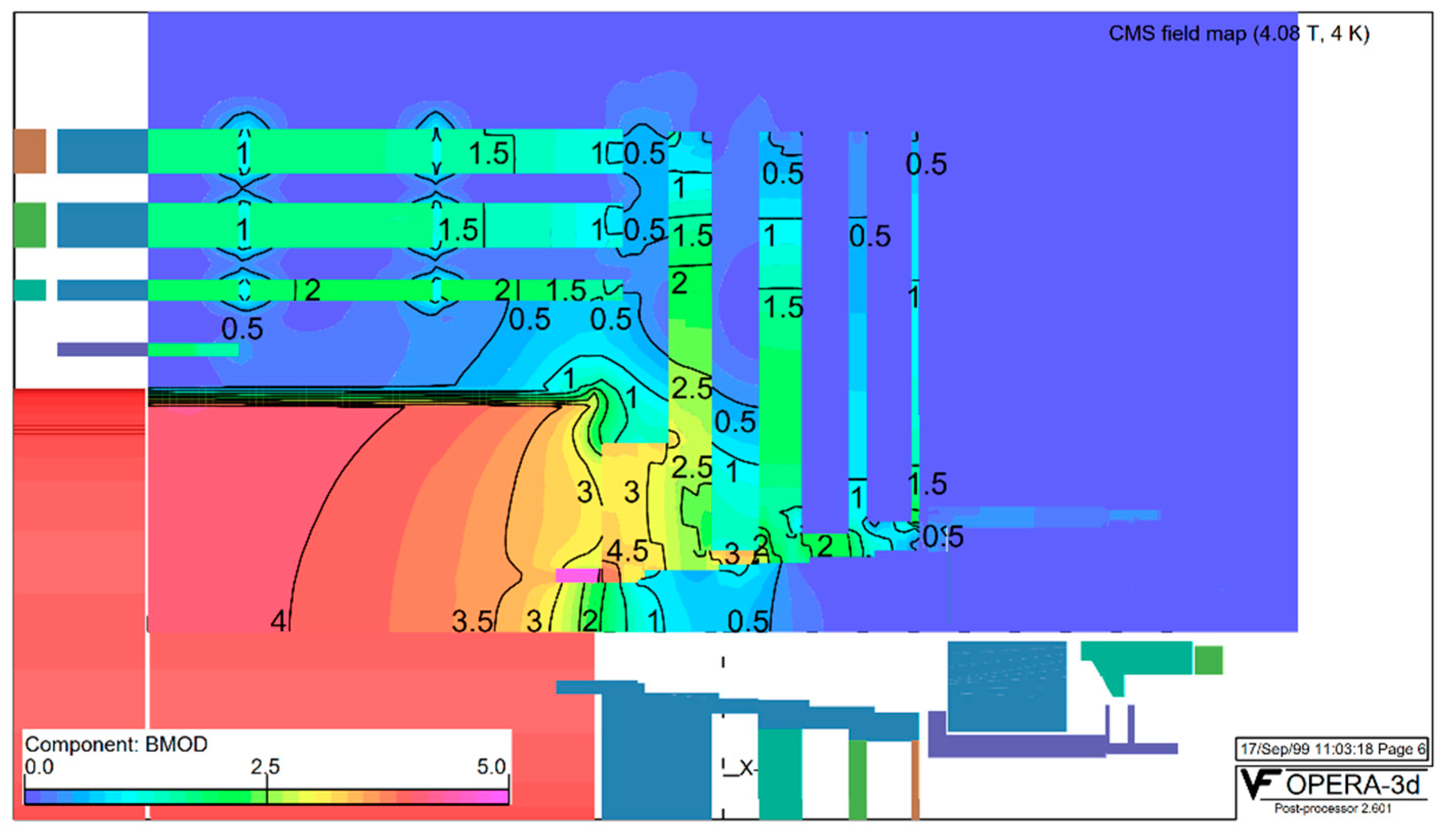
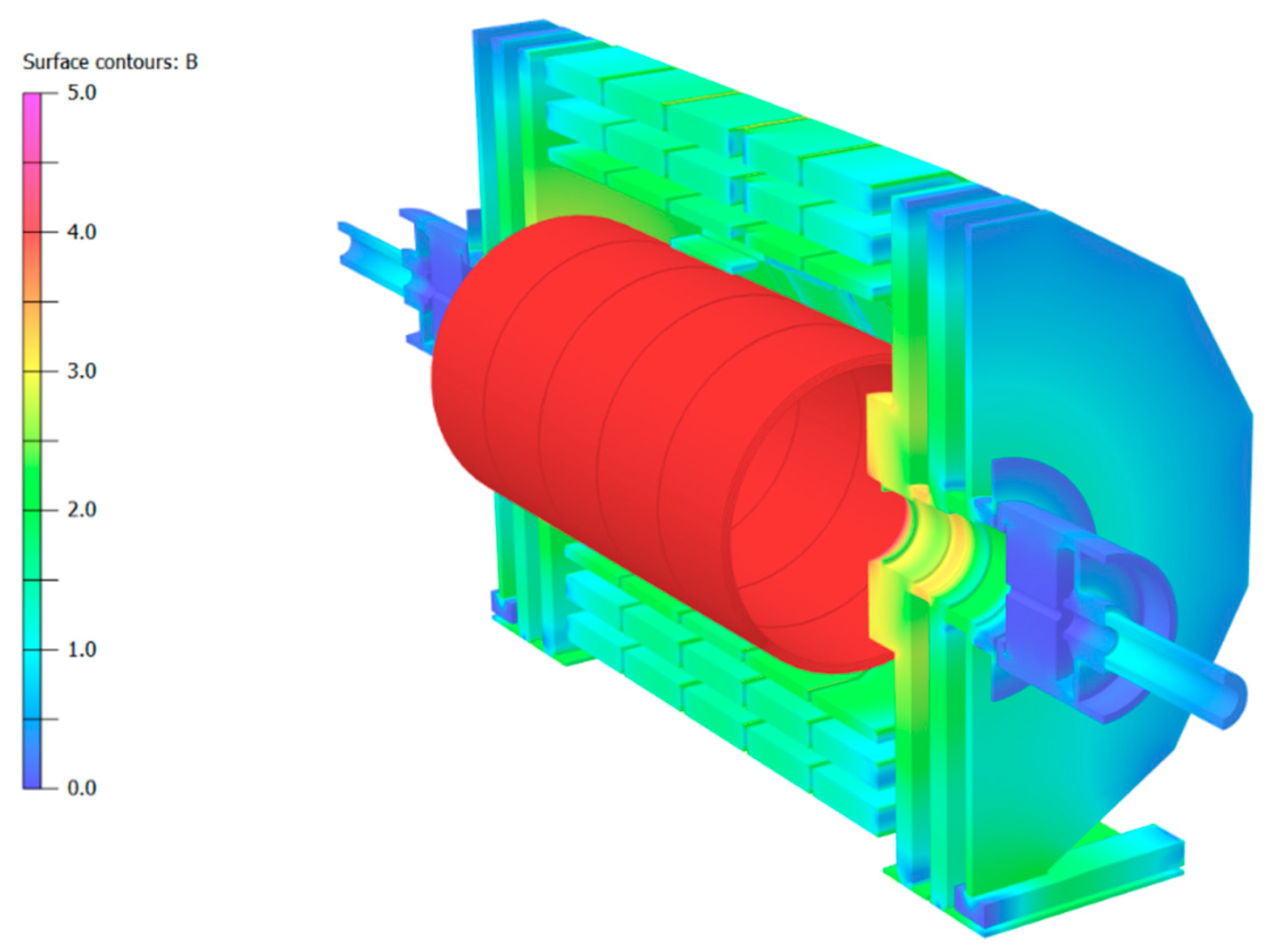
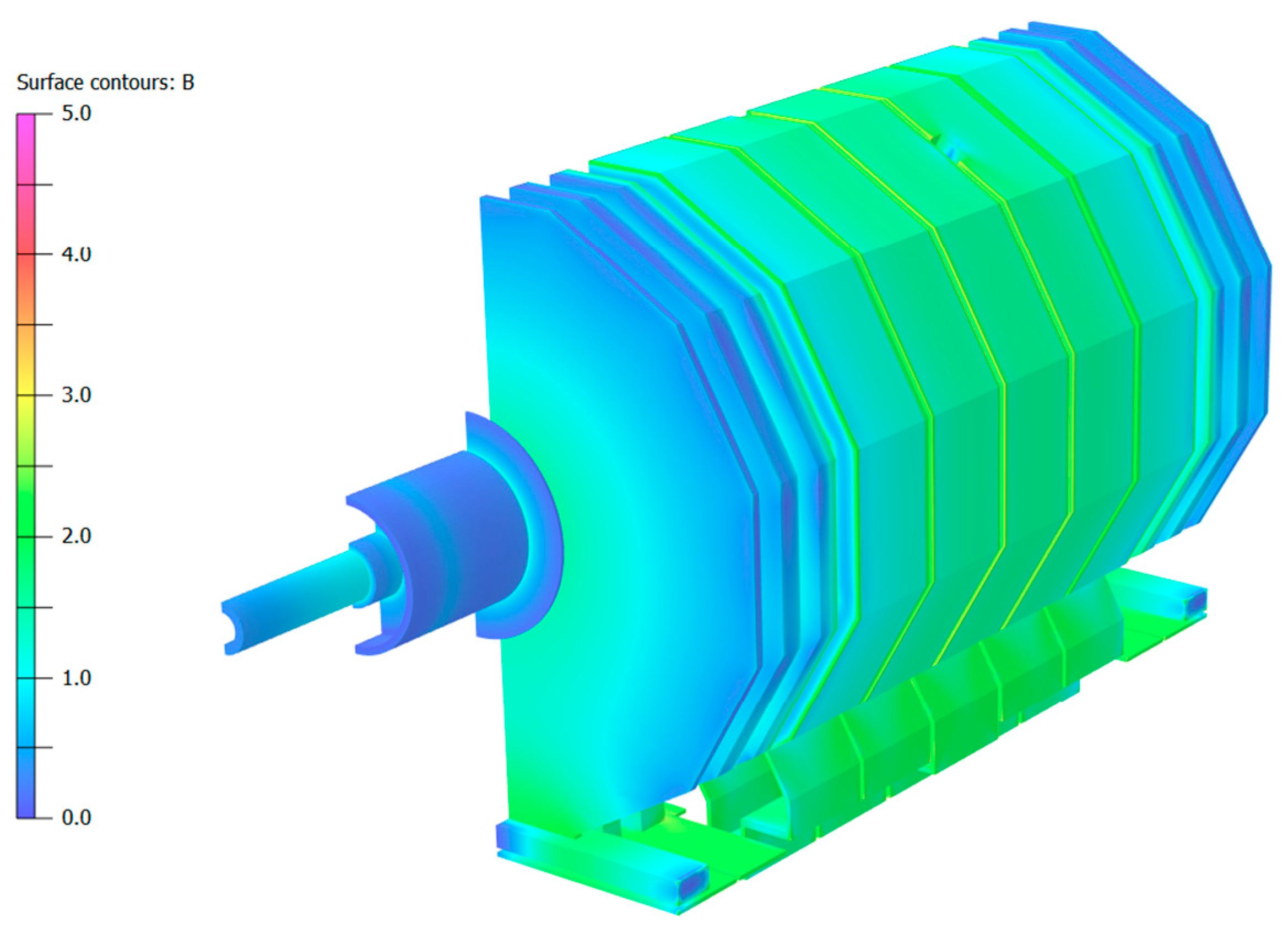
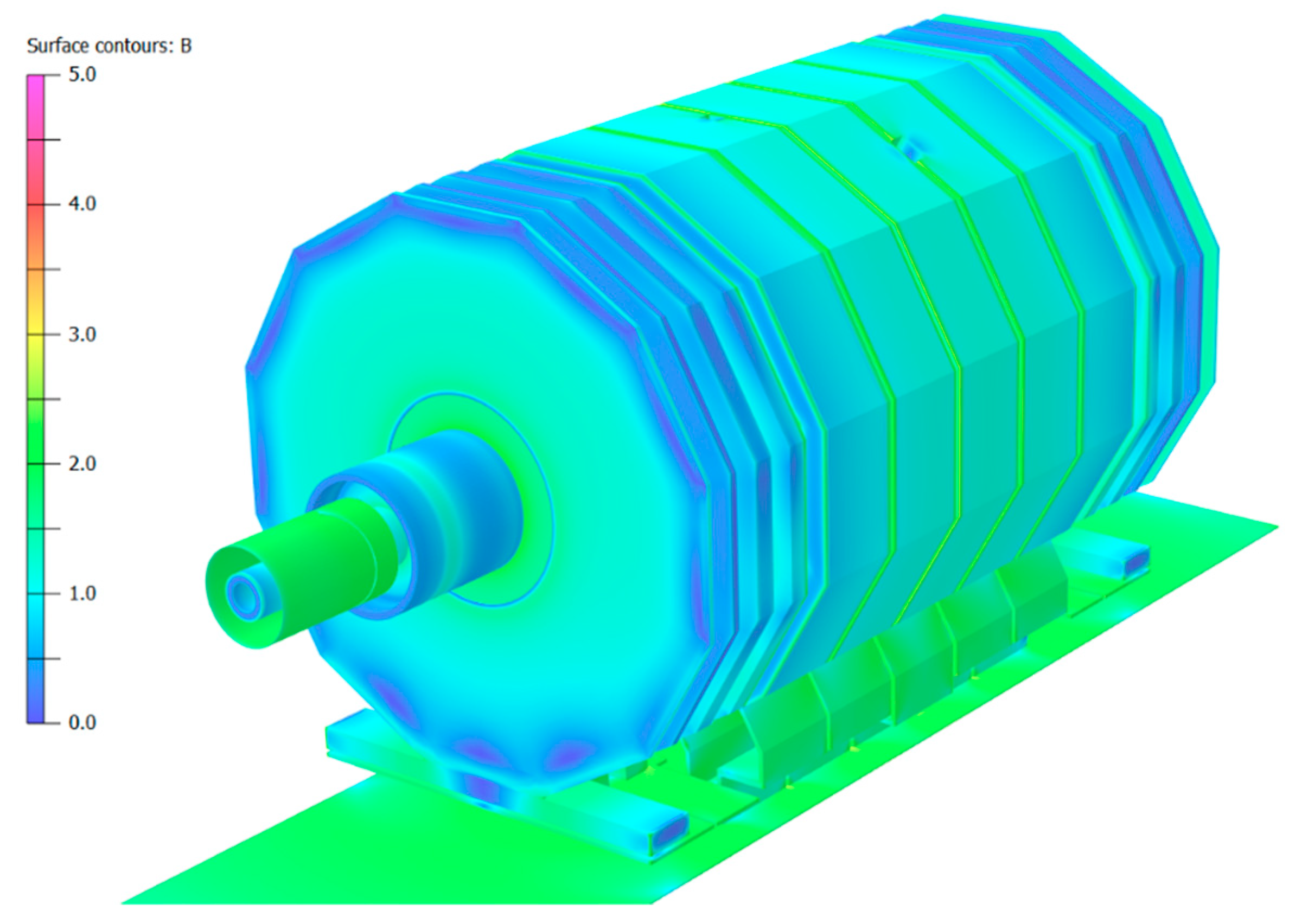
Publisher’s Note: MDPI stays neutral with regard to jurisdictional claims in published maps and institutional affiliations. |
© 2021 by the author. Licensee MDPI, Basel, Switzerland. This article is an open access article distributed under the terms and conditions of the Creative Commons Attribution (CC BY) license (https://creativecommons.org/licenses/by/4.0/).
Share and Cite
Klyukhin, V. Design and Description of the CMS Magnetic System Model. Symmetry 2021, 13, 1052. https://doi.org/10.3390/sym13061052
Klyukhin V. Design and Description of the CMS Magnetic System Model. Symmetry. 2021; 13(6):1052. https://doi.org/10.3390/sym13061052
Chicago/Turabian StyleKlyukhin, Vyacheslav. 2021. "Design and Description of the CMS Magnetic System Model" Symmetry 13, no. 6: 1052. https://doi.org/10.3390/sym13061052





